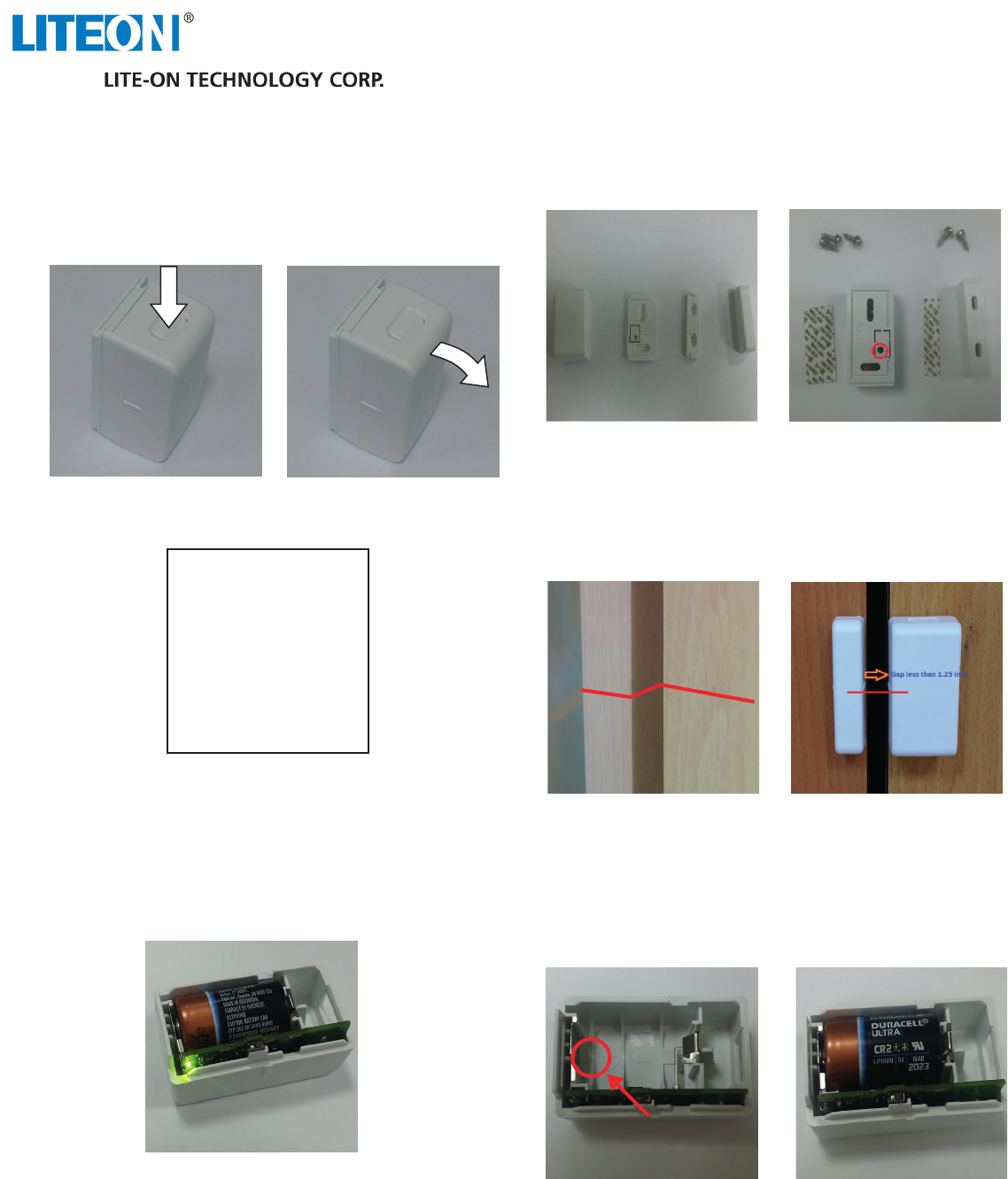LITE ON TECHNOLOGY CHS888 Door Window Sensor User Manual Print
LITE-ON Technology Corp. Door Window Sensor Print
User Manual

The Lite-On Door Sensor (CHS-888) can be easily installed on a door,
window cabinet, garage door or anywhere that can be opened.
Before Installation
Activate Battery
1. Press the release catch on top (g.1).
2. Remove the top case (g.2).
3. Pull the plastic tab o to activate the sensor (g. 3). The door
sensor will start to scan for the network and ash LED 3 times.
Pair & Register
1. Follow the instructions on your Touchstone Hub or Touchscreen,
to add new Door Sensor (CHS-888).
2. During the pairing mode, the status LED will ash until the sensor
is connected. (g. 4)
Notes: A scan is performed every 5 seconds.
The LED ashes 3 times when each scan is initiated.
The sensor sleeps between scans to conserve battery.
If after 20 scans a network is not found, the sensor enters into sleep
mode.
The sensor resumes scanning the next time a zone status change
occurs (e.g. fault, restore, tamper, tamper restore, test button
pressed, etc.) This allows user interaction to cause the sensor to
resume scanning.
If you still have problems to pair the sensor, you may follow the
factory reset procedure to reset to factory defaults.
Installation
1. There are four key parts inside the pack. Starting from left to right:
Door Sensor, Door Sensor Mounting Bracket, Magnet Mounting
Bracket and Magnet. (Photo 3)
2. Depending on the installation location, you may decide to use
double-sided tape or self-tapping screws to install the door
sensor. The tamper hole on the rear case (red circle in g. 6) must
be screwed in for tamper protection.
3. Test the door sensor before installation
4. If the installation locations are not level (g. 6), you can add a
bracket to the door sensor or the magnet to rectify this.
5. The sensor has an alignment mark on one side of the case
indicating where the magnetic switch is located. The magnet
should be mounted adjacent to the magnetic switch (g. 8)
6. The distance between the magnetic switch and the magnet
should be less than 1.25” (g. 8).
7. The movement of the magnet away from the magnetic switch
causes the zone to fault or sets o the alarm.
Battery replacement
1. Press the release catch on top (g. 1)
2. Remove the case cover (g. 2)
3. Remove the battery and replace with a CR2 type battery ensuring
that you orient the battery so that the positive pole matches the
positive mark on the case. (gs. 9 & 10)
Door Window Sensor (CHS-888) User Guide
g. 1
g. 3
g. 5 g. 6
g. 7 g. 8
g. 9 g. 10
g. 2
g. 4

Factory reset
1. Open unit and remove battery
2. While holding down the tamper switch (g. 11), install battery
3. Wait for 4 seconds
4. Release tamper switch
5. The LED will ash for 2 seconds and wait to join the network.
6. If the sensor is NOT enrolled (i.e. does not have a CIEAddress and
ZoneState = Enrolled)
a. Illuminate the LED for 2 seconds to indicate a successful boot
b. Remove any existing network parameters from previous
network commissioning attempts
c. Reset to factory defaults
LED indications
LED Status Description
Illuminated the LED is on
Flashing the LED should turn on for 300 mS and then
turn o for 300 m
O the LED is turned o
FCC Statement
This device complies with Part 15 of the FCC Rules. Operation is subject
to the following two conditions: (1) this device may not cause harmful
interference and (2) this device must accept any interference received,
including interference that may cause undesired operation.
This equipment has been tested and found to comply with the limits for
a Class B digital device, pursuant to part 15 of the FCC rules. These limits
are designed to provide reasonable protection against harmful
interference in a residential installation. This equipment generates, uses
and can radiate radio frequency energy and, if not installed and used in
accordance with the instructions, may cause harmful interference to
radio communications. However, there is no guarantee that
interference will not occur in a particular installation. If this equipment
does cause harmful interference to radio or television reception, which
can be determined by turning the equipment o and on, the user is
encouraged to try to correct the interference by one or more of the
following measures:
• Reorient or relocate the receiving antenna.
• Increase the separation between the equipment and receiver.
• Connect the equipment into an outlet on a circuit dierent from
that to which the receiver is connected.
• Consult the dealer or an experienced radio/TV technician for help.
You are cautioned that changes or modications not expressly
approved by the party responsible for compliance could void your
authority to operate the equipment.
FCC RF Radiation Exposure Statement:
1. This Transmitter must not be co‐located or operating in
conjunction with any other antenna or transmitter.
2. This equipment complies with FCC RF radiation exposure limits set
forth for an uncontrolled environment. This equipment should be
installed and operated with a minimum distance of 20 centimeters
between the radiator and your body.
IC Statement
This device complies with Industry Canada licence-exempt RSS
standard(s). Operation is subject to the following two conditions: (1)
this device may not cause interference, and (2) this device must accept
any interference, including interference that may cause undesired
operation of the device.
Le présent appareil est conforme aux CNR d'Industrie Canada
applicables aux appareils radio exempts de licence. L'exploitation est
autorisée aux deux conditions suivantes : (1) l'appareil ne doit pas
produire de brouillage, et (2) l'utilisateur de l'appareil doit accepter tout
brouillage radioélectrique subi, même si le brouillage est susceptible
d'en compromettre le fonctionnement.
Industry Canada - Class B
This digital apparatus does not exceed the Class B limits for radio noise
emissions from digital apparatus as set out in the interference-causing
equipment standard entitled “Digital Apparatus,” ICES-003 of Industry
Canada.
Cet appareil numérique respecte les limites de bruits radioélectriques
applicables aux appareils numériques de Classe B prescrites dans la
norme sur le matérial brouilleur: “Appareils Numériques,” NMB-003
édictée par l’Industrie.
Operation is subject to the following two conditions: (1) this device may
not cause interference, and (2) this device must accept any interference,
including interference that may cause undesired operation of the
device.
L'opération est soumise aux deux conditions suivantes: (1) cet appareil
ne peut causer d'interférences, et (2) cet appareil doit accepter toute
interférence, y compris celles susceptibles de provoquer
fonctionnement du dispositif.
To reduce potential radio interference to other users, the antenna type
and its gain should be so chosen that the equivalent isotropically
radiated power (e.i.r.p.) is not more than that permitted for successful
communication.
An de réduire les interférences radio potentielles pour les autres
utilisateurs, le type d'antenne et son gain doivent être choisie que la
puissance isotrope rayonnée équivalente (PIRE) est pas plus que celle
premise pour une communication réussie.
RF exposure warning: The equipment complies with RF exposure limits
set forth for an uncontrolled environment. The antenna(s) used for this
transmitter must not be co-located or operating in conjunction with
any other antenna or transmitter.
Avertissement d'exposition RF: L'équipement est conforme aux limites
d'exposition aux RF établies pour un incontrôlés environnement.
L'antenne (s) utilisée pour ce transmetteur ne doit pas être co-localisés
ou fonctionner en conjonction avec toute autre antenne ou
transmetteur.
Avertissement d'exposition RF: 1. Cet emetteur ne doit pas n'etre
coimplante ou operation en meme temps qu'aucune autre antenne ou
emetteur. 2. Cet equipement est conforme aux limites d'exposition de
rayonnement de la FCC rf determinees pour un environnement non
controle. Cet equipement devrait etre installe et actionne avec une
distance minimum de 20 centimetres entre le radiateur et votre corps.
CAN ICES-3 (B)/NMB-3(B)
g. 11